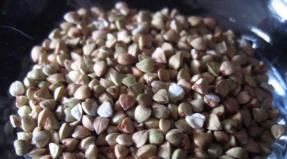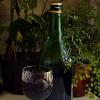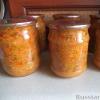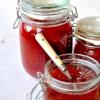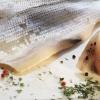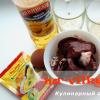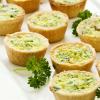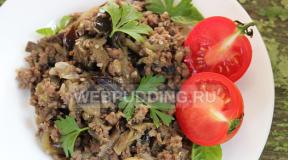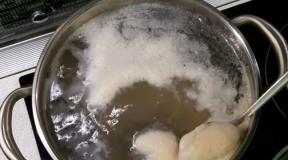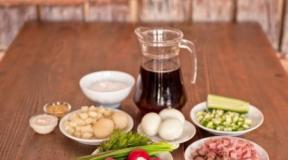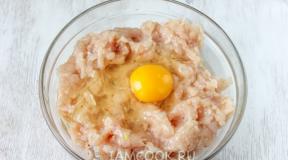Eid al-Fitr Muslim salads and snacks. Three dishes that will decorate every table for Eid al-Adha What to cook for Eid al-Adha
As you know, Muslims have two biggest holidays - Eid al-Fitr (Eid al-Fitr) and Eid al-Adha (Eid al-Adha). They are widely celebrated by both practicing and ethnic Muslims.
Islam unites different cultures and peoples. Islamic traditions, the Sunnah of the Prophet Muhammad (s.a.w.) becomes a unifying factor for carrying out certain events, especially. Therefore, it is not surprising that even the culinary traditions of different nations are very similar.
The two main Muslim holidays traditionally last three days. During these days, it is customary everywhere to visit and host people. Usually they visit friends and relatives. And these days the Ingush have open doors to everyone without exception. Anyone can come to the house, and they will not be denied hospitality - they will feed and drink.
National dishes of different nations
Muslim cuisine is predominantly meat-based. Most often they use beef or lamb; the steppe Turkic peoples use horse meat.
One of the most common dishes among Muslims is pilaf. In Russia, it is most often prepared according to Uzbek or Tajik recipes. This is a meat dish made from lamb with the addition of spices, sometimes chickpeas. Pilaf is placed in the center of the table on many holidays, not only religious ones. For example, there is a tradition in honor of the birth of a child. In this regard, sometimes the meat is either distributed or a common meat dish is made.
Varieties of pilaf vary depending on the area. If Tajiks and Uzbeks cook it with spices and very fatty, then the Kazan Tatars prefer without seasonings, cooking with garlic and prunes, and the Kazakhs add apples and dried apricots. In the Caucasus, pilaf will be sweet with the addition of all kinds of dried fruits. Usually these are raisins and dried apricots.
If you want to surprise your guests with an unusual pilaf, we recommend preparing the Azerbaijani version, known as Shah-pilaf. The peculiarity of this dish is that it is made with a crust of pita bread, dough or noodles, which is called gazmah. To prepare, you will need traditional ingredients, so every housewife can do this delicacy: rice, lamb, ghee, saffron, raisins, dried apricots, onions, etc. How to cook shah pilaf is clearly shown in this video:
Indian Muslims and Pakistanis call pilaf biriyani- This is a special traditional and very popular dish with the addition of special seasonings, including turmeric, cardamom and red hot pepper. Therefore, the dish turns out to be very spicy. It is eaten not only on holidays, it is included in the everyday menu.
The most popular Kazakh dish is beshbarmak(besbarmak), which are pieces of boiled meat with noodles that are eaten with your hands. It is an integral part of the holiday table. The Chechen national holiday dish is very similar to it zhizhig galnash(translated as “dumpling meat”), which is also prepared from lamb, beef or chicken with dumplings made from wheat or corn flour.
Famous Avar khinkal also consists of lamb or chicken with fluffy flatbreads made from wheat dough. The difference between this dish is that it is served with some kind of sauce.
Soups are popular among the Tatars. Therefore, they often prepare chicken noodle soup. Even on the wedding day, the bride, according to tradition, must prepare this dish herself and serve it to the guests. In addition to soup, meat baked goods are very common among the Tatars. Therefore, traditionally served triangles (ochpochmak), peremyachi And whites.
This festive dish is very interesting and tasty. kurutob. This is a very common Tajik dish. Pieces of flatbread are immersed in grated cottage cheese with milk, covered with slices of fresh cucumbers, tomatoes and herbs.
The holiday food of many Turkic peoples is shurpa(sorpa) - rich meat broth with the addition of vegetables and herbs. It is worth noting the hearty Azerbaijani soup bozbash on a meat bone (or brisket) with vegetables and chickpeas. For aroma and taste, dried fruits and currants are added to it. There are a great many options for preparing bozbash. The recipes differ in spices and some additives, but the main ingredients - meat and chickpeas - are always preserved.
For many Muslim peoples, it is common to decorate the festive table with dishes made from offal. Especially on Eid al-Adha. This is due to the fact that they deteriorate faster and are impractical to store. On the 1st day, housewives usually prepare dishes from the liver and heart. On the 2nd day - soup of lamb heads and shanks. The main dishes are stewed meat, stir-fries with rice, legumes or vegetables. And already on the 3rd day the turn comes to soups on lamb bones, pilaf, shish kebab, lagman, manti, beshbarmak and many other traditional dishes.
Festive cuisine in Malaysia is interesting. The main dish on the festive table is rice fried with vegetables and shrimp. In addition to it, the Malays delight themselves and their guests with such culinary delights as satay(a dish reminiscent of kebab, but much smaller in size), nasi lemak(a rice dish cooked in coconut milk - chopped eggs, anchovies, nuts and cucumbers are added to it). Try to prepare this dish according to the very convenient recipe presented in the video, and make sure that this is exactly what will suit your holiday table!
Also popular in Malaysia is a chicken broth made with small compressed rice cubes called soto. Another, again rice, dish - lontong. It consists of vegetables with rice and thick gravy.
Holiday sweets and desserts among Muslim peoples
In the East, sweets are treated with special love. The variety of these delicacies is known all over the world. All kinds of jams, flour products, sweet products made from honey, nuts and fruits become integral attributes of any feast.
The list of the most famous sweets includes baklava- dessert made from puff pastry in sweet honey syrup with nuts. According to one opinion, Persia is considered the birthplace of baklava, others believe that the Ottoman Empire. Be that as it may, today baklava is a national delicacy of Turkey, Azerbaijan, Arab and other eastern countries. Every place has its own cooking features, but the main ingredients remain the same.
In second place in popularity and fame is halva. People in Russia are accustomed to seeing halva made from sunflower seeds on store shelves. But in fact, it can be very diverse. Halva is prepared from sesame seeds, peanuts, almonds, pistachios and other nuts. But in the North Caucasus, in particular among the Chechens, halva is prepared from corn flour, and less often from wheat flour. This dessert is served only on special occasions - for Eid al-Fitr and weddings. The secret of making Chechen halva lies in frying flour with honey so that it turns into a tender cake.
Using flour and honey, Tatars, Bashkirs and Kazakhs create their own unique delicacy - chuck-chuck And baursak. They are the hallmark of the traditional cuisine of a number of Turkic peoples.

Sweets that do not have a national connection are also nougat and Turkish delight (known as Turkish Delight) - honey and nuts are used for their preparation.
Some peoples, for example, Azerbaijanis, prepare cookies sheker-buru. It is a crescent-shaped dough that is sprinkled with nuts, mainly almonds. The recipe is reminiscent of making homemade traditional cookies.
To get a portion of sheker-bura for 6-10 people you will need:
- premium flour - 4 cups;
- butter - 1 pack (180-200 g);
- egg - 1 pc.;
- sugar - 1 glass;
- milk - 0.5 cups;
- slaked soda - 0.5 teaspoon.
Known to many Kurabye- also an Azerbaijani national delicacy. This is probably why it is also called “Baku”. However, kurabiye is a widespread oriental sweet, which also differs in its preparation methods in each country.
The sweet pastries that traditionally decorate the festive table are also varied among the Tatar people. In addition to chak-chak, a favorite and traditional pastry for celebrations is Gubadia- pie with rice, kort (fried sweet cottage cheese), boiled eggs and raisins, sour cream and other baked goods.
In Muslim cuisine, as already noted, Malaysian and Indian cooking stands apart. Traditional Indian sweets such as jalebi or laddoo, are very popular among Muslims living in this country. Although some of them are prepared by Hindus as offerings to local deities, they are common tasty sweets among Muslims.
In Malaysia, desserts are a little unusual, very different from traditional dishes. The cuisine of this people was influenced by the culinary traditions of neighboring countries: Thailand and Singapore. For example, kui ketayap- thin pancakes dyed green with pandan leaves and stuffed with grated coconut and palm sugar syrup. During the holiday, guests are sure to be served the Malays' favorite dessert - chendol- green bean puree with sugar in a thick coconut pulp sauce.
The range of Muslim holiday cuisine is wider than presented in our article. Describing all the features, one could compose an entire cookbook. We wanted to introduce you to the main dishes.
Bon appetit! Eid Mubarak!
After the festive prayer, tables are set, people invite guests or visit relatives themselves, and give each other gifts.
TASS correspondents learned the recipes of national dishes that different peoples of Russia prepare for the holiday.
The first to share recipes was the production manager of the Kazan mosque Mardzhani Rauza Safiullina. She revealed the secrets of making Tatar gubadia - a closed round multi-layer pie, and echpochmak - a triangular pie.
Tatar Gubadia
Ingredients:
For the test: 400 g premium flour, 1 egg, 100 ml milk, 200 g softened butter, 1 tsp. salt, 1 tbsp. sugar, 30 g raw yeast.
For filling: 5 eggs, 500 g rice, 300 g kort (burnt cottage cheese), 150 g raisins, 150 g butter, 2 tbsp. Sahara.
For the baby: 150 g flour, 50 g butter, 1 tbsp. Sahara.
Cooking method:
Mix together butter, milk, yeast, salt, sugar, egg. The dough itself should be soft. After this, the dough needs to be put in the refrigerator for a few minutes so that it rises. Then divide the dough into two parts: 400 g of dough for the bottom of the pie, 200 g for the top. Place the bottom part in the pan and add the filling: first a small amount of rice, the next layer is kort. Then sprinkle the filling with sugar and add 3-4 tablespoons of melted butter. After this, mix 350 g of rice with 150 g of raisins and a spoonful of sugar and place it on the court in the next layer. Add mashed boiled eggs and 10 tablespoons of butter. Cover the pie with the top layer of pastry and place in the oven for 45 minutes. The top of the gubadia should be sprinkled with crumbs of flour, butter, and sugar.
In Kazan, the finished court is sold in stores. But if you can’t find it in your region, you can prepare the court yourself. There are several different recipes for this. Let's give two of them.
Court: take 300 g of cottage cheese, add 150 ml of milk, a little sour cream, sugar and boil in a saucepan until thickened over low heat for about two hours, until the cottage cheese turns brown.
Or pour 1.5 liters of fermented baked milk into a bowl with a thick bottom and place on high heat. Ryazhenka will begin to separate almost immediately. When the liquid has almost evaporated and the consistency resembles thick semolina porridge, reduce the heat and cook, stirring continuously, until the korta turns into crumbly light brown grains. Add melted butter and sugar to taste.
Tatar echpochmak with beef
Ingredients:
For the test: 1 glass of water, 1 egg, 1 tsp. yeast, 1 tsp. salt, sugar to taste, 3 cups (or 350 g) flour, 3 tbsp. sunflower oil.
For filling: 500 g beef, 10 potatoes, 3 onions, salt and black pepper to taste, 2 tbsp. sunflower oil.
Cooking method:
Filling: Cut the beef, potatoes, onions into small cubes, season with salt and black pepper, add oil and let it brew for a while.
Dough: Dissolve yeast in a glass of warm water, add egg, salt and sugar. Mix all this with flour, add sunflower oil, knead the dough and leave in a warm place for an hour and a half. Once the dough has risen, divide it into small balls and roll out into flat cakes. Then put the filling on the flatbreads, lift the edges of the dough on three sides, pinch so that there is a small hole in the middle and place in the oven. Echpochmak bakes for about 45 minutes.
Chechen zhizhig-galnash
Chechen dumplings (galnash) with meat are served with beram sauce and washed down with broth. Galnash is made from wheat or corn flour. They differ in their unique shape, which, of course, depends on the hostess and her masterly ability to handle the dough. Galnash made from wheat flour are oblong, thin, about 4 cm in length, and those made from corn flour are oval and flattened. We offer you an option with wheat dumplings.
Ingredients:
1 kg of meat (beef, lamb or chicken), 1 kg of wheat flour, chicken egg, 1 head of garlic, 1 head of onion, water, salt to taste.
Cooking method:
Meat: Place the onion and the meat cut into large pieces in a saucepan, add water so that it covers all the meat, and place on high heat. Skim off any foam that has formed. Once boiling, reduce the heat until the broth simmers and add salt. Cook the meat as if for jellied meat - it should become soft, tender and easily fall off the bone.
Galnash: make a mound of flour, break the egg directly into the flour and add salt. Starting from the sides, collect the flour in the center, gradually adding warm (almost hot) water, and knead the dough until it has the consistency of dumplings. Then divide the dough into five parts. Roll out each part into a sausage with a diameter of approximately 2 cm. Using a knife, cut the dumplings approximately 1 cm wide. To form the galnash, first press a piece of dough with your fingers, then place your palm on top and roll it along the table in your direction. Place the dumplings on a well-floured surface. Shake off excess flour and cook in broth until tender (until they float to the surface).
Sauce: Grind the garlic with coarse salt and pour in the broth. You can also prepare onion sauce: sauté the onion, add butter, broth and hyoj yogi butz, that is, thyme.
Serve zhizhig-galnash as follows: place dumplings on large plates, small pieces of meat on top, and beram sauce in a separate gravy boat.
Sok from Karachay-Cherkessia
This unusual sweet recipe from Nogai cuisine is quite popular, despite its labor intensity.
Ingredients:
1 kg of millet, 400 g of sour cream (20%), 400 g of ice cream, sugar to taste.
Cooking method:
Sift the millet, rinse well and pour into boiling water. Cook for about 10 minutes. As soon as the grains begin to swell, take them out, place them on a white canvas cloth and let them dry a little. When the millet has cooled, fry it in a dry, preheated casserole, stirring constantly until the millet acquires a dark golden hue. After this, take out the millet, let it cool and sift again. Place in boiling water and cook for about 3 minutes, then strain and cool. It is advisable to let the juice sit for a day.
Before use, millet must be steamed with milk or water. In the latter case, the dish turns out less fatty. Classic juice is seasoned with sour cream and sugar is added to taste. But you can use cream or ice cream instead of sour cream.
Khychin from Kabardino-Balkaria
Khychin is a traditional Balkar and Karachay pie. The thickness ranges from 3 mm to more than a centimeter. There can be three types: baked on coals, baked in a frying pan and fried in oil. The filling can be meat, beet tops, nettles, cabbage, pumpkin, cheese - the list goes on and on. However, khychin with potatoes and cheese is considered classic, the recipe for which we offer you.
Ingredients:
For the test: water, flour, salt.
For filling: 250 g of peeled potatoes, 500 g of Balkar cheese (preferably full-fat), 30–40 g of butter (or 20–25 g of sour cream), salt to taste.
To lubricate the finished khychin: butter, 15 g per piece.
Cooking method:
Filling: Boil and mash the peeled potatoes. Grate the cheese on a coarse grater and mix with the potatoes. To make the filling softer and fattier, you can add melted butter or homemade sour cream. Add salt to taste. Divide the filling into pieces and shape them into balls (6–7 cm in diameter).
Dough: knead unleavened, soft dough, as for regular bread. Divide into pieces, roll into balls with a diameter of 5 cm, cover with a napkin and leave for 5-10 minutes. Flatten the dough ball a little, place the filling ball on it, lift the edges of the dough and pinch at the top - the filling ball will be inside. Then roll it all out thinly.
Khychin: Bake the flatbread in a frying pan without oil, first on one side, then on the other, until browned (about the size of a pancake). When the khychin is ready, it inflates like a balloon. Grease the finished khychin generously with oil on both sides. Before placing on the table, cut into four parts. It is customary to serve ayran with khychin.
Crimean Tatar chiberek
This delicious dish has many names. The most common of them is cheburek. But the Crimean Tatars, who claim that this is their national dish, say that it is correct to call it chiburek or chiberek, says Zera Emirsuin, a specialist at the Spiritual Administration of Muslims of Crimea. According to him, when frying chiberek, windows and doors are opened in the house so that the aroma spreads throughout the area. Housewives pile them up on dishes and distribute them to neighbors.
Ingredients:
For the test: 600 g of premium flour, warm salted water.
For minced meat: half a kilo of beef, 3-4 onions, salt, pepper, 3 tbsp. water.
Cooking method:
Add warm salted water to the flour, gradually stirring the dough until it becomes plasticine so that it does not stick to your hands. Place the resulting “bun” of dough in the refrigerator for an hour and a half. You can simply cover the dough with a towel and let it sit. After time has passed, cut pieces of dough from the “bun” and roll them into sausages with a diameter of 5 cm. Cut the sausages into pieces and roll into balls. Then roll the balls into flat pancake-type cakes 0.3–0.5 cm thick. To prevent the dough from sticking to the rolling pin when rolling, add flour.
Place the minced meat (about 1 tbsp) on one side of the “pancake”, cover the other half of the “pancake” with the other side and glue the edges together with a special device called “chygyryk” (a machine with a rotating wheel). The edges of the chiberek are jagged and do not allow air and minced juice to pass through.
Heat vegetable oil in a deep frying pan, reduce the heat and start frying the chibereki. First, fry one side until golden brown, then turn over to the other side.
Place the finished chibereks on a large tray. Katyk (yogurt) with herbs, vegetable salad or pickles are ideal for this dish.
Regional editorial office of TASS
Islam-today correspondents interviewed representatives of Muslim peoples about their national traditions of celebrating Eid al-Fitr and the features of the holiday.
Uzbekistan,Sabo
Eid al-Adha is the most important holiday of the year, more important than birthdays and New Years. On the three holidays on the occasion of Eid al-Fitr, we should be free from worries and affairs. Eid al-Fitr is a day of leaving behind anger, reconciliation and distribution of fitr sadaqah. For the Feast of Breaking the Fast and during the month of Ramadan, we make sure to prepare the Uzbek dish nishalda, a marshmallow-like sweet. The refectory table - dastarkhan (a low table among the peoples of Central Asia) - is furnished with national Uzbek dishes, numerous fruits, Uzbek chak-chak, various flatbreads, pastries, manti and invigorating dried apricot compote. There is always a persimmon on every table - this is a heavenly fruit, which is often used to break the fast in Uzbekistan. In Uzbekistan, women are not allowed to go to the mosque, so we performed the Eid prayer at home. In Kazan, on Eid al-Fitr we go to the mosque. After the holiday prayer, people go to the cemetery to the graves of their deceased relatives and read prayers.
We make cotton candles by hand the day before and soak them in oil, so that the next day we burn each of them at the graves of the dead before prayer. There is a custom of holding funeral dinners, reading the Holy Quran in memory of the dead; Lamb shurpa is served on such a table.
On the holidays of Eid al-Fitr, Uzbeks visit and congratulate their parents, grandparents and relatives, families visit each other and share the joy of the sacred holiday. In Kazan, Uzbek families carefully observe all customs in order to preserve national traditions.
Türkiye, wjournalist Nevzat Yaldirim
This holiday in Turkey is celebrated for 3 days. First, all men go to the mosque for festive prayer. Upon return, parents give their children pocket money in varying amounts, depending on the family’s income. In the morning, small children begin to go from house to house with bags for gifts: candy, sweets, eggs. Children in Turkey call Eid al-Adha and Eid al-Adha “Shakir Bayram”. Be sure to visit relatives. Public transport is free during the holidays in Istanbul.
The dishes served on the festive table are varied and no longer depend on where the province is located: in the north, west, south-east of the country. This can be lentil soup chorba, meat, fish dishes, sweets - baklava.
Tajikistan,Abubakr Hazrat Azizov
Eid al-Fitr is celebrated for 3 days. Before the holiday, parents take their children to the bazaars, buying them new clothes and skullcaps. On the eve of Eid al-Fitr and Kurban Bayram, men take ghusl (ablution) in the bathhouse, go to the mosque for morning prayer and for Gait prayer. After prayer, they visit the graves of relatives and read dua for the dead. These days, women prepare national dishes: pilaf, shurpa, pastries. Mosques also prepare holiday meals for people. After dinner at home, Muslims go to each other, friends, relatives, treat themselves, read the Koran, and congratulate them on the holiday. The hosts set the festive table and wait for the guests to come for 5-10 minutes, eat a little, drink tea, read the Koran, and make dua to Allah. You need to go around all the houses and streets of the village, eat at least a piece of flatbread, congratulating your neighbors and relatives, so as not to offend them. Some families prepare large tables of food, inviting relatives and loved ones to eat. Children go from house to house, congratulating them on the holiday, wishing the owners good things from Allah. They are given gifts - sweets, chocolates, eggs. There is a very strong feeling of celebration.
Dagestan,Hadji-Murat Radjabov, editor "IslamDag.ru"
In international Dagestan, each nation, each village has its own national dishes that they prepare, its own table setting. People of different nationalities can come to visit for the celebration of Eid al-Fitr, so they cook in such a way as to please everyone. On holidays you can see a very rich, beautiful table with a variety of dishes for every taste. Various types of halva, chak-chak pie, meat dishes, painted boiled eggs, Dargin, Avar, Lak chobu soup, cabbage rolls, different types of pilaf.
Children come in droves with bags in their hands to visit. Children are welcome in any home. The doors are not locked. They are treated to sweets, chocolates, and candies.
Azerbaijan,Ilshat
Eid al-Fitr is an Islamic holy holiday, it is a day of mercy, friendship, and mutual assistance to each other. On the Feast of Breaking the Fast, we give fitr-sadaqa, go to the mosque for festive prayer, and congratulate each other. We spend Eid al-Fitr with family and relatives. The table is set as usual, it always contains tea and dates.
Syria,Abdullah
Eid al-Fitr is one of the most important holidays for Muslims, which is celebrated for three days. In the morning, after the general holiday prayer in the mosque, Arabs go en masse to cemeteries to visit the graves of relatives. The graves of the dead are sprinkled with water, a reyhan (basil) plant is placed on top and Surah al-Fatiha is read. Everyone in the city, acquaintances and strangers, congratulates each other. A grandiose atmosphere of universal celebration and joy reigns in Arab cities. We give fitr sadaqa to poor people in the form of money or food. In honor of the holidays of Eid al-Fitr, people who are in a quarrel make peace and forgive each other.
The most important thing on this holiday is family. All relatives first gather with the oldest member in the family. These are either grandparents, or parents, and if they are no longer alive, then the eldest son in the family. A large family has dinner together, relatives congratulate each other. On other days, Arab families go to visit more distant relatives and friends.
For the holiday, the whole family puts on new beautiful clothes and dresses up. If one of the family members is in prison, then relatives visit such prisoners.
In Syria, women prepare special sweets for Eid al-Fitr (mamoul - cookies with dates or pistachios, klezhe, etc.). The rich festive table is decorated with numerous Arab national dishes made from legumes, rice and meat.
In Tatarstan, we celebrate Eid al-Adha not as magnificently as in our homeland. The main problem is that many residents do not celebrate and do not know the essence of this holiday; there is no atmosphere of solemnity. In Russia, Arabs go to the mosque for holiday prayers, close friends gather together, and parents are congratulated via telephone or the Internet.
The world of Islam is very large and diverse. By the will of Allah Almighty, residents of many countries have become Muslims. The peculiarities of each people are reflected in the general culture and traditions of world Islam. The wealth of traditions, on the one hand, emphasizes the uniqueness of ethnic groups, on the other, the unity of Muslims who make up one ummah, one community of people who believe in one Allah and recognize Muhammad (peace and blessings be upon him) as His Prophet.
Lent for the faithful is coming to an end. It will be followed by an important celebration - Eid al-Adha. To break the fast, festive dishes should be prepared. Study the suggested recipes, set a magnificent table and invite friends and family to share with them the joy of completing the fast.
The month of Ramadan is a special period for all Muslims, because it is one of the months of the year in which, according to the instructions of the Koran, one should cleanse oneself of sinful thoughts, repent, and turn to the Almighty.
This time is called Uraza (Oraza) - a period during which Muslims observe a special meal schedule, significantly change their diet, and also spiritually cleanse themselves through prayers.
The end of this period is Oraza-it. This is the holiday of breaking the fast.
On this day, you should invite friends, family and friends to jointly celebrate the end of Ramadan (Ramadan). Cover a rich dastarkhan to make the celebration a success.
We suggest making the following dishes:
Lagman

This national dish of the Uyghurs will give an unforgettable taste sensation to household members and guests.
The combination of products developed over centuries creates an unforgettable aroma and taste. The main thing is to follow the recipe exactly.
For 8 servings of lagman you will need:
- lamb (tenderloin) - 1 kg;
- radish (daikon or Margelan) - 1 pc.;
- eggplants - 2 pcs.;
- green beans - 200 g;
- onions - 4 pcs.;
- sweet red pepper - 2 pcs.;
- large tomatoes - 6 pcs.;
- cilantro and celery - a bunch each;
- garlic - 7 cloves.
To achieve the ideal taste of the dish, use, in addition to salt, hot pepper (chili) - 1 pod and 3 tbsp. l. ground coriander.
Long homemade noodles are the basis of lagman. To make it, use the following products:
- water - 400 ml;
- chicken eggs - 3 pcs.;
- flour - 7 tbsp;
- salt - 3 tsp;
- soda - ½ tsp.
Vegetable oil is also useful for frying ingredients and lubricating noodles. 150 ml is enough.
You can implement this recipe by going through several steps:
- Prepare the noodles.

- Beat eggs with salt and 1.5 cups of water.
- Sift the flour and make a well in the middle. Pour the egg mixture into it and gradually knead the dough.
- Make a soda solution - mix soda in 50 ml of water. Dip your hands into it and wipe the dough. Knead until it becomes elastic.
- Knead the dough and make a rope out of it. Repeat these steps three times.
- Roll out the dough into a flat cake, cut it into strips up to 3 cm wide.
- Pull these strips out and form them into long ropes up to 1 cm thick. To simplify this process, dip your hands in vegetable oil and pass the strip between your fingers, twisting it.
- Grease the dish where you place the prepared noodles. Leave the finished spirals for 30 minutes. Don't forget to cover with cling film.
The noodles should be boiled in lightly salted water, preferably 1 bundle at a time or several at a time for up to 5 minutes.
Using a slotted spoon or colander, carefully place into portioned plates and drizzle with oil.
- Prepare sai (gravy). For this:
- Cut the lamb into small pieces.
- Chop all the vegetables into strips, cut the pods in half, chop the greens.
- In a cauldron, fry the meat until golden brown, add celery and coriander. Simmer for 10 minutes.
- Add vegetables to the meat and simmer until fully cooked. If there is little liquid in the cauldron, then add a little at a time the water in which the lagman was boiled.
- Prepare laza chang (seasoning).
Chop the cilantro and garlic, mix with finely chopped or grated hot pepper. Add 50 ml of heated vegetable oil to this mixture.
Place noodles, sai and seasoning in each bowl.
Baursaki
This is one of the favorite dishes of Kazakhstanis. It is characterized by ease of preparation and availability of products. Baursaks are light, fluffy and extremely tasty.
If you want to cook airy baursaks with a golden crispy crust, then use this recipe:
- cottage cheese - 0.6 kg;
- chicken eggs - 4 pcs.;
- sour cream - 50 g;
- sugar - 5 tbsp. l.;
- salt and soda - 1 tsp each. without top;
- flour - 4–5 glasses.
For frying, use half a liter of vegetable oil.

The main thing in baursaks is the dough. To prepare it:
- Add soda, salt and sugar to sour cream. Stir everything thoroughly.
- Beat in the eggs and mix everything thoroughly.
- Grind the cottage cheese in a blender so that there are no lumps, sift the flour. Add these ingredients to the sour cream mixture.
- Make portioned balls and fry in a deep pan in a large amount of vegetable oil.
Beshbarmak

This is the leader in popularity among the dishes preferred by Kazakhstanis.
We suggest preparing an unusual beshbarmak from lamb offal.
For this dish use:
- ribs (lower part) - 1.5 kg;
- heart - 4 pcs.;
- kidneys - 6–8 pcs.;
- onions - 3 pcs.;
- greens (cilantro, parsley) - 1 bunch each.
You will also need flour (400 g) and chicken eggs (4 pcs.). For frying, take vegetable oil (0.5 l).
Hot pepper and cumin are suitable as special seasonings for this dish. Just like salt, add them based on your own taste preferences.
Prepare beshbarmak in this way:
- Preparatory stage involves the following actions:
- Processing meat by-products: rinse the ribs and remove the film, cut off the vessels from the hearts and cut them into eight pieces. Peel the buds from films, cut them in half and soak in water for 1–2 hours. This way you will remove the unpleasant odor.
- Chop the onion into half rings.
- Prepare the dough: add eggs and a little salt to the flour. Knead the dough and roll it into thin flat cakes. Cut these blanks into strips, and those, in turn, into diamonds. These pieces should be dried naturally. Therefore, leave them for 40–60 minutes, sprinkled with flour.

- Heat treatment products:
- Boil ribs and hearts in salted water. Add the peeled onion and parsley sprigs. Drain the cooked meat in a colander.
- Fry the boiled semi-finished products in vegetable oil, add kidneys and onions cut into pieces. Simmer over medium heat until done. Add salt and cumin as needed.
- Pour out ½ of the broth, and add chopped onion to the rest. When the liquid boils, throw the dough diamonds into it. Cook until half cooked (approximately 2-3 minutes). The dough should be dense.
- Place the meat components on a large platter and place the diamonds on top. Sprinkle the dish with chopped herbs.
Prepare these amazing and nutritious dishes, make the feast colorful and rich.
The holiday should be remembered for fun, joy, delicious food and pleasant communication.
On September 12, the main Muslim holiday began - Kurban Bayram. Food is one of its most important components. What dishes would a gala dinner be without and what is the daily routine of those celebrating, said Zarema Tagirova, a culinary blogger and connoisseur of Tatar cuisine.
The "Feast of Sacrifice", or Kurban Bayram, is the most important holiday for Muslims. It begins 70 days after the end of the thirty-day fast in the month of Ramadan and coincides with the day the pilgrimage to Mecca ends.
Kurban Bayram is celebrated for three days, starting at sunrise, and before the holiday, 10 days of fasting are observed - uraza. Believers wash themselves, put on clean clothes and visit the mosque for the festive morning prayer - namaz, with the reading of a sermon, and also visit cemeteries in order to honor the memory of deceased relatives. The final stage of the holiday is the sacrifice of any animal - a ram, goat, camel or bull, and the age of the ram should not be more than a year, and the bull or cow no more than two years. The animal must be healthy and not have any physical defects; it is sacrificed in accordance with the canons: a prayer is read, and the meat is divided into three parts - one is given to needy and poor people or left in the mosque, the second part is used in the preparation of festive dishes, which They treat relatives, friends and neighbors, and the third part remains in the owner’s house. Meat should not be stored, it must be eaten at the end of Eid al-Adha, and the bones must be buried.
What is prepared for the holiday from sacrificial meat? On the first day - dishes from offal: liver and heart. The second day begins with a bowl of soup prepared in broth from lamb heads and shanks. Prepare stews and roasts, supplemented with rice, legumes and vegetables. On the third day, soups made from lamb bones, pilaf, shish kebab, lagman, manti, beshbarmak, chuchvara and many other traditional dishes appear on Muslim tables.
A special place on the festive table is given to sweets, which are usually used to decorate tables and give gifts to children. On Eid al-Fitr, baked goods are usually prepared using almonds and raisins: these are all kinds of oriental cookies, pies and biscuits.
Dishes for the festive table
Jiz biz
Jiz biz- a dish of shepherds, which they ate and eat on their long journeys through the pastures. Liver cannot be stored for a long time, which is why this dish is quickly prepared and eaten immediately. Lamb offal is a storehouse of vitamins and flavors. The dish uses the whole liver, according to your taste - liver, heart, kidneys, lung, peritoneum, spleen and lamb eggs (for the male variation of jiz-byz). Jiz-byz is prepared in a saj (a concave steel or cast iron frying pan with two handles on the sides - editor's note), or in a cauldron or wok.
Ingredients (for 4 persons):
set of lamb liver (liver, lung, heart, spleen) - 1 pc.
onions - 4-5 pcs.
vegetable oil/tail fat - 3-4 tbsp. spoons
garlic - 2-3 cloves
bell pepper - 2-3 pcs.
tomatoes - 3-4 pcs.
coriander - 1 tsp.
ground black pepper and salt to taste
Cooking method:
Peel the onion and wash. Finely chop and set aside for a while. Wash and chop bell peppers and tomatoes. Wash the lamb liver set. Cut each component separately. Heart - remove ducts and blood clots. Chop the liver coarsely, removing excess film. Also chop the lungs and spleen not very finely.
In a cauldron, dissolve the butter with a clove of garlic. Once it turns brown, you need to remove it from the oil. Fry the heart first for 1-2 minutes, then add the liver, then the lungs and spleen. Mix thoroughly and fry for a minute.
Finally, add onions, chopped tomatoes and peppers. They will add flavor, juice and softness to the dish. Simmer, stirring, 5 minutes. At the end of the dish you need to salt, pepper and add coriander. Before serving, sprinkle with coarsely chopped cilantro.
Salad "Eastern"
Not the last place on the festive table is occupied by salads with liver and meat. The oriental salad is variable and can be prepared with liver, or with boiled beef or lamb. All products must be chopped into strips.
Ingredients (for 4 persons):
boiled lamb liver or beef - 200 gr.
tomatoes - 3-4 pcs.;
pickled cucumber - 3-4 pcs.;
bell pepper - 3-4 pcs.;
red onion - 1 pc.;
cilantro;
vegetable oil - 2-3 tbsp;
soy sauce - 1/2 tsp;
apple cider vinegar - 1/2 tsp;
freshly ground pepper;
sea salt;
sesame.
Cooking method:
Clean the lamb liver from ducts and films, cut into thin strips and fry for 1-2 minutes in a well-heated frying pan.
Wash all vegetables and dry. Chop the onion into half rings and set aside. Cut tomatoes, peppers and cucumbers into thin strips.
In a bowl, combine soy sauce, apple cider, vegetable oil, salt and pepper. Mix everything. Check for acid-sweet balance.
Place vegetables and liver in a bowl and season with sauce. Place the salad on a plate, sprinkling sesame seeds on top.
Shulum
Shulum- This is a rich, satisfying soup made from meat, coarsely chopped vegetables and herbs. As a rule, it is cooked over an open fire, and the choice of vegetables depends on seasonality. The meat chosen is shanks, shoulder blades and other components of lamb, as well as beef, poultry and game.
Ingredients (for 4-6 persons):
Lamb (shank) - 2 kg;
onions - 2 pcs.;
bell pepper - 10 pcs.;
potatoes - 6-8 pcs.;
tomatoes - 8-10 pcs.;
parsley - 200 g;
cilantro - 200 g;
basil - 200 g;
dill - 200 g;
salt;
peppercorns;
freshly ground pepper;
chilli.
Cooking method:
Chop the lamb into pieces of 100-150 grams. Peel the onion. Pour cold water into the pan, add meat and onions. You can't add salt for the first 40 minutes. After boiling, skim off the foam, reduce heat and simmer for 1 hour.
Peel the potatoes and cut into large slices. Add to the broth after 40-45 minutes of cooking. Cut the sweet pepper into strips. Cut the skin of the tomatoes crosswise, pour boiling water over them and peel them. Cut into slices. After cooking the meat for an hour, add peppers and tomatoes to the pan.
Finely chop all the greens. 10 minutes before it’s ready, we start adding it: first dill and parsley, then after a couple of minutes basil, and when the soup is ready - cilantro.
Shah-pilaf
Pilaf- a dish that unites people, traditions and nations at one table. There are a great many variations of it, but one of the most striking representatives of holiday pilaf is Shah-pilaf, a dish of Azerbaijani cuisine. The name comes from its appearance, which resembles the crown of medieval eastern rulers.
A characteristic feature of Azerbaijani pilaf is gazmah (this word cannot be translated into Russian - editor's note). It's a crust of pita bread, dough, or noodles, and a bottom layer of rice that sticks to it. The essence of gazmakh is that, when fried, it prevents the burning of rice. A special round iron sheet is often placed under the cauldron, which prevents the pilaf from burning and promotes uniform temperature distribution.
Ingredients (for 4-6 persons):
long grain rice (preferably Basmati) - 200-300 grams;
lamb (pulp) - 500-600 grams;
ghee or fat tail fat;
salt;
saffron - a pinch.
Gazmah:
thin pita bread - 2-3 pcs.;
ghee - 80 grams;
sesame.
Shirin-ashgara:
dried apricots - 80 grams;
raisins (quiche-mish) - 80-90 grams;
ghee.
Zirvak:
onion - 1 piece;
medium carrots - 1 piece;
mixture for pilaf (barberry seeds, cumin, chili pepper, cumin) - 1 tsp.
Cooking method:
Rice: At least 3-4 hours before preparing the pilaf, thoroughly rinse the required amount of rice. Pour in water, sprinkle salt on top and leave aside. It is important to do this in advance, so it will cook faster. Pour saffron into a cup, pour boiling water over it, cover with a saucer, and let sit for at least 4 hours or overnight.
Fill the largest saucepan with water (there should also be a lot of water, as the rice swells when cooked) and place on high heat. Add a lot of salt, a few tablespoons. As soon as the water in the pan begins to boil, pour the water in which the rice was soaked into it. As soon as everything boils again, add rice, stirring. When it is cooked, drain in a colander and cool.
Ashgar width: Rinse the dried fruits, place in a saucepan and add water until it covers them completely. Put on fire and simmer. Once the water has evaporated, add oil. Fry the ashgar over medium heat for 3-5 minutes, then let cool.
Zirvak: Chop carrots and onions into strips. Place the pilaf mixture in a dry cauldron and heat it up. Add butter or tail fat, heat a little, then fry the vegetables until golden brown.
Cut the lamb into pieces, add in parts to the cauldron, sealing them on all sides. Add a little water and simmer with zirvak for 30 minutes.
Gazmag: cut thin pita bread into strips 1.5-2 cm wide.
Assembling Shah Plov: Grease a cauldron or mold with melted butter, sprinkle with sesame seeds and lay sliced lavash overlapping around the entire perimeter. Its ends should hang over the walls of the cauldron. Brush with ghee again. Then lay out a layer of rice, a layer of zirvak with lamb, a layer of ashgar, and repeat everything again by analogy.
Finishing touch: Add a little oil to the pre-soaked saffron and pour the pilaf over the entire surface. Line the top of the pilaf with the pieces of lavash that hung from the cauldron, brush with melted butter and cover with a lid. Place the cauldron on the fire or in a preheated oven at 180 C for 1 hour.
Before serving, turn the pilaf upside down and cut into pieces.
Cookies "Shaker-puri"
The culinary art of the East was created and is being created by women. In any family, regardless of income, the ability to cook is passed on from generation to generation. This is the essence of the life and traditions of peoples. The mother does not write down recipes: her daughters have been watching her for years as she works her magic in the kitchen. All girls and women know the golden rule from childhood: “Your eye is the best scale.”
Oriental cuisine is famous for its abundance of sweets and desserts. Many of them are based on spices, fruits and dried fruits, and nuts. On Eid al-Fitr, desserts containing almonds are preferred. Shaker-puri cookies are a delicacy that is used to greet and treat guests with tea, and is also given to children.
Ingredients (for 6-10 persons):
premium flour - 200 g;
butter - 100 g;
almond flour - 80 g;
cinnamon - 1/2 tsp;
egg - 1 pc.;
yolk - 1 pc.;
powdered sugar - 100 g;
milk - 125 ml;
vanilla sugar - 20 g;
baking powder - 5 g.


